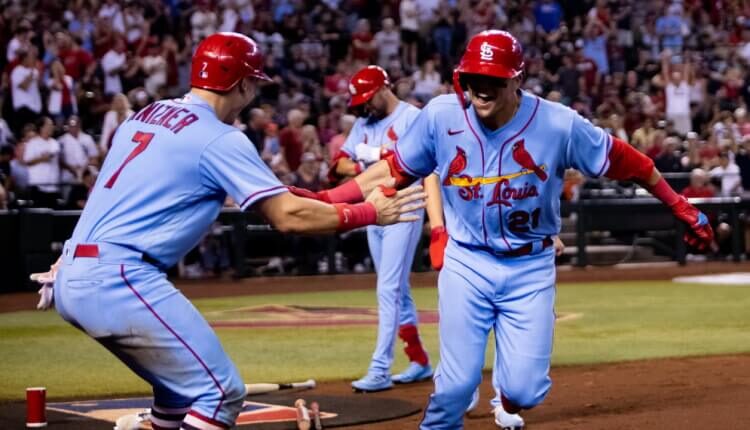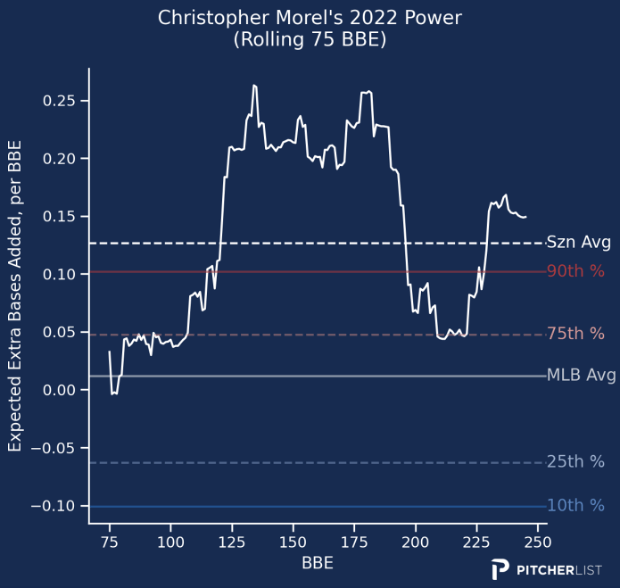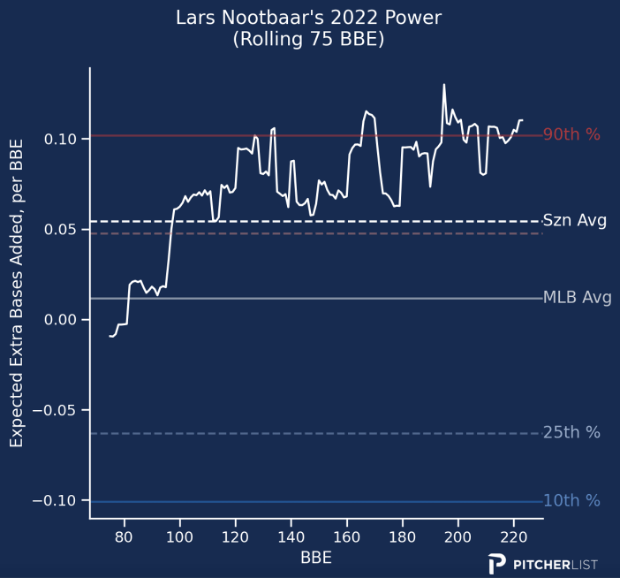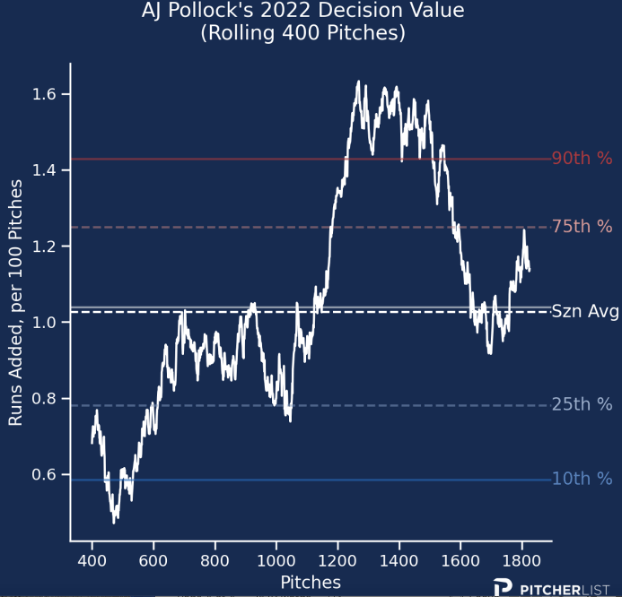In an article last week, I looked at the second halves that we should be ignoring. Using xwRC+, I identified hitters that got lucky and unlucky during the second half and whose stat lines were not indicative of their true performance. In the same way, xwRC+ can be used to identify which second halves we should be paying attention to. Some players either saw a steep decline or increase in their skill set during the second half which can be used as indicators of 2023 performance. This article looks at two second-half slumps and two second-half surges that we should be paying attention to during 2023 drafts.
The season is not here yet, but why not get a head start and jump in a Fantrax Classic Draft contest? Get a jump on the season with a Best Ball league or maybe a Draft and Hold. Or put some green on the line with a new season-long league to try and conquer. There’s no better time than now to get your baseball on!
Second Half Slumps to Pay Attention to:
Austin Hays- OF, Baltimore Orioles
Austin Hays has never quite lived up to the hype he generated after an excellent start to his Minor League career. Hays has been slightly above-average each of the last two seasons posting a 106 wRC+ in 2021 and 105 in 2022. However, his 2022 numbers are inflated by a strong start to the season. After posting a 122 wRC+ during the first half, Hays hit just .220/.276/.349 with a 78 wRC+ during the second half. xwRC+ believes his second half was even worse than it looked. His second half xwRC+ of 76 highlights major concerns with Hays’ profile and indicates you should be fading him in 2023 drafts.
Before the 2022 season, Austin Hays was generating hype after posting a career-high barrel percentage in 2021. One of the biggest issues with his 2022 second half was the disappearance of this barrel rate. After the All-Star Break, Hays posted just a 1.8%-barrel rate. As a result, Hays saw his power numbers take a massive dip with just four home runs. There is nothing unlucky about a 1.8%-barrel rate. The gains Hays appeared to make in 2021 disappeared and took his fantasy value with them.
So, what changed? Why did Hays suddenly see his power skills disappear? In 2021, Hays slugged .568 off the four-seam fastball with a positive seven-run value. The script flipped in 2022 as Hays posted a negative seven-run value with a .406 slugging percentage. In particular, Hays really struggled with fastballs thrown above the zone. I ran a Statcast search looking at Hays in pitches thrown in the upper part of the zone, specifically the upper nine sections of the strike zone. The table then shows how pitchers started adjusting to exploit his weakness.
Pitchers recognized they could beat Hays with fastballs up and started to rely on that as an easy way to get him out. The inability to consistently make solid contact is the main reason xwRC+ does not believe in Hays. The drop in power is clearly correlated to his inability to hit the high fastball and will likely continue to impact Hays in 2023.
The model is also not a fan of Hays’ chase rate. On the season Hays chased over 36% of the time (the highest rate of his career). This actually improved during the second half but is still extremely concerning. His second-half struggles led to reduced playing time last season. Baltimore is flush with young talent and any hiccup from Hays in 2023 could result in him being on the bench.
Hays is currently going as OF64 in fantasy drafts ahead of players like Lane Thomas and Brandon Marsh. The xwRC+ model believes his second-half slump was deserved and there is a good chance we see this continue in 2023. The Orioles are likely to give Kyle Stowers some playing time and Hays could find himself on the short side of a platoon. I am avoiding Hays in drafts and so should you.
Christopher Morel- UTIL, Chicago Cubs
Upon his promotion, Christopher Morel was an instant spark to the Cubs’ lineup. Across his first 15 Major League games, Morel posted a .268/.373/.464 slash, with two home runs (one on his first big league at-bat), and six stolen bases. Morel was picked up virtually everywhere thanks to his blend of power and speed. Morel continued his success throughout the first half posting a 128 wRC+, but things took a turn for the worse after that. Over the second half of the season, Morel hit just .194/.269/.376 with an 82 wRC+. His xwRC+ indicates that his performance was even worse than the surface stats. His power and speed might tempt you to buy back into Morel for 2023, but the model strongly suggests avoiding him.
There is no questioning Morel’s raw power. Throughout last season, Morel posted a 91st percentile barrel rate along with an 88th percentile max EV. The graph below shows just how impressive Morel’s power actually is.
Morel experienced a slight reduction in barrel rate during the second half (15.4% to 10.6%) which impacted his xwRC+, but this rate is still well above league average. The model has no issue with the quality of contact that Morel posts but rather the frequency with which he makes contact.
Morel’s issue throughout the Minor Leagues was a consistently high strikeout rate. That issue was only amplified in the Major Leagues. Last season there were seven hitters with at least 200 plate appearances to post a whiff rate greater than 35% and a zone-contact rate below 70%.
- J.D. Davis, Joey Gallo, Chris Taylor, Brett Phillips, Jo Adell, Christopher Morel, and Keston Hiura
That is not the list of hitters you want to draft on your fantasy team. Morel has some of the worst contact skills in baseball which pitchers exploited during the second half. Morel saw his chase percentage increase from 30.1% in the first half to 37.9% during the second half while his whiff rate went from 29.7% to 39.3%. This decline in contact skills is the main reason why xwRC+ believes his second-half slump was warranted.
Morel does have the ability to contribute speed to your fantasy team. Morel posted 88th percentile sprint speed to go along with ten stolen bases. As noted in my previous article discussing Spring Training position battles, Morel is not guaranteed a spot in the lineup or even on the Cubs’ Opening Day roster. Morel spent most of the 2022 season playing second base and center field. After signing Dansby Swanson and Cody Bellinger those positions are now occupied. Morel is going to have to beat out Patrick Wisdom to get at-bats at third base. Morel is versatile but is not a particularly good defender at any position. Speed without time in the lineup is useless in fantasy which is exactly what could happen with Morel.
The model sees no room for optimism based on his second half performance. Plate discipline issues and poor contact skills are nothing new for Morel and the fantasy industry needs to accept that this is who he is. If Morel’s bat is unable to keep him in the lineup, there is very little chance he sees regular playing time. Do not pay up for Morel’s speed as his 2022 second-half slump will likely roll into 2023.
Second Half Surges to Pay Attention to:
Lars Nootbaar, OF St. Louis Cardinals
Of course, Lars Nootbaar made it into one of my articles before the start of the 2023 season. Nootbaar is this year’s wide-awake sleeper pick. Everybody seems to be picking Nootbaar as their breakout pick for this season. Nobody was paying any attention to Nootbaar this time last year. That is when news broke that he was working with Driveline and was able to add 8 mph of bat speed to his profile. He did not receive regular playing time for St. Louis during the first half batting just .200/.277/.378 in 101 plate appearances. Nootbaar finally got his opportunity after the All-Star Break and did not look back. He posted a 140 wRC+ during the second half which is completely backed up by a 139 xwRC+. Let’s dig deeper to figure out why the model loves Nootbaar so much.
Good plate discipline is a surefire way to help the model fall in love with you. There were only nine hitters during the second half to walk as much as they struck out. Nootbaar was one of them and the only person with a higher walk rate was Juan Soto. Nootbaar ranked in the 92nd percentile in terms of chase rate on the season. He simply does not expand the zone. Walks do not always help in standard leagues, but for points and OBP leagues Nootbaar’s value is incredibly high.
Another way for the model to fall in love with a player is good quality of contact. During the second half, Nootbaar posted a barrel rate of 14.1% with an average exit velocity over 91 mph. The bat speed he picked up while working at Driveline clearly paid off in a big way and helped Nootbaar to a .240 second-half ISO.
Nootbaar demonstrated elite power performance throughout the season, but especially once he started getting everyday at-bats during the second half. xwRC+ is not questioning the power potential here and neither should you.
Nootbaar has never hit for much average or posted high BABIPs, but there is upside here as well. He hits the ball extremely hard with above-average speed. His sweet spot percentage improved last year which signals a more consistent swing path. In 26 plate appearances without the shift last year, Nootbaar hit .400. Now that the shift is gone and Nootbaar is in a regular role we could see his average creep up close to .250. With elite walk rates and excellent power, a decent average is all Nootbaar needs to set him over the top.
Nootbaar’s 139 second half xwRC+ ranked 11th in all of baseball. Ahead of guys like Juan Soto, Ronald Acuna, Mookie Betts, and Shohei Ohtani. The hype for Nootbaar is deserved and he has a chance for a monster season. His draft price over the past month is OF41 around guys like Cody Bellinger and Oscar Gonzalez. Both players posted a 100 xwRC+ for reference. Being able to draft a player with a 139 xwRC+ that low is an incredible value. Draft Nootbaar and expect results like his second half of 2022.
AJ Pollock- OF, Seattle Mariners
Things did not exactly work out for AJ Pollock in Chicago. During his one season on the White Sox, he posted the worst wRC+ (over a full season) of his career. Career worsts in batting average, slugging percentage, chase rate, and whiff rate does not provide much encouragement for a player entering his age 35 season. Looking deeper, Pollock showed signs of life during the second half. After the All-Star Break, Pollock slashed .265/.318/.449 with a 117 wRC+. xwRC+ believes his second-half surge was legit and now with Seattle, Pollock should get the chance to play almost every day. He is worth a look in drafts where he currently goes as OF108.
The early results of 2022 point to a player on a new team who was pressing for results. Through the first half, Pollock was batting .227/.268/.333 and had lost significant playing time in Chicago’s lineup. He was chasing over 40% of the time with a swinging strike rate of 13.9%. Pollock was struggling to even make contact on the fastball. He whiffed on 36.7% of fastballs in April, 23.5% in May, and 26.3% in June. Pollock has always been known as a fastball hitter, but this was the opposite of what happened during the first half. However, from July forward, Pollock did not whiff on the fastball more than 16.3% of the time in any month. As Pollock’s stats against the fastball improved so did the rest of his numbers.
Pollock had posted a barrel rate of at least 10% in three of the past four seasons entering 2022. During the first half, he was barreling up baseballs only 8.5% of the time. This is an above-average rate, but disappointing for Pollock. During the second half, his rate increased to 10.2%. Pollock’s power improved during the second half, but he was also just experiencing poor luck during the first half. Only four of his 17 barrels went for a home run during the first half. This 23.5% rate is well below the league average and bounced back in the second half.
The most significant area of improvement for Pollock in the second half was in his plate discipline. xwRC+ believes that Pollock was significantly better in the second half thanks to improved contact rates and decreasing chase rates. His chase rate decreased to a much more manageable 35% and the swinging strike rate down to 9.4%. The PLV chart below shows just how dramatic the improvements in his decision value were during the second half.
Pollock finally started to look comfortable at the plate and much like the hitter we have come to expect over the last several years. As fantasy baseball players and analytic lovers, we sometimes forget to take into account the human element of the game. Pollock was traded before the season to a new team in a new city. He has a proven track record of production and consistency so maybe we should discount his early-season struggles.
Pollock was a productive hitter during the second half and his success is backed up by xwRC+. The model believes his stat line accurately reflects his true talent level. Now in Seattle, there are some concerns over him becoming a platoon bat. Sam Haggerty and Jarred Kelenic have not shown enough at the Major League level to think Pollock will lose at-bats and now is an ultimate buy-low opportunity. At his draft price, he is well worth the selection based on his 2022 second-half success.
Are you buying in on any of these second half surges? What about the slumpers? For more great analysis check out the 2023 FantraxHQ Fantasy Baseball Draft Kit!







